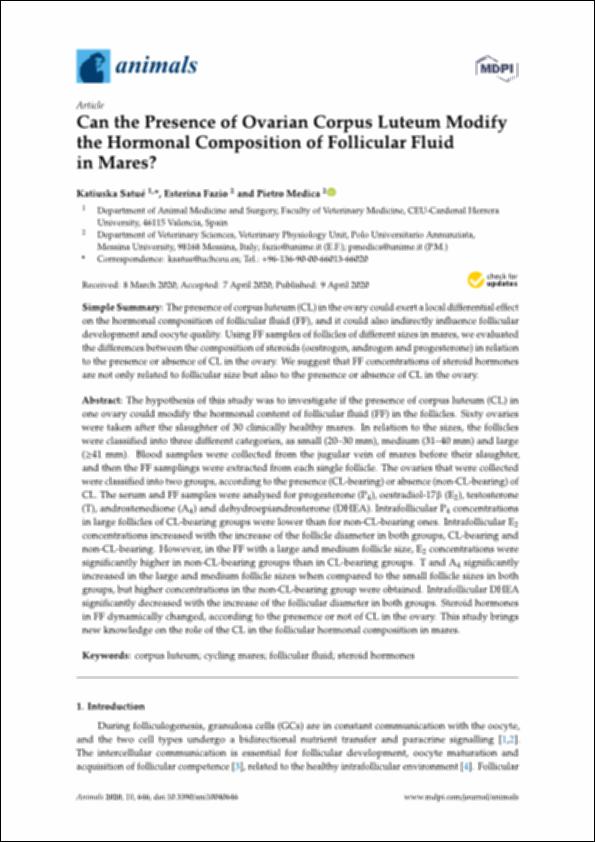Please use this identifier to cite or link to this item:
http://hdl.handle.net/10637/12534Can the presence of ovarian corpus luteum modify the hormonal composition of follicular fluid in mares?
| Title: | Can the presence of ovarian corpus luteum modify the hormonal composition of follicular fluid in mares? |
| Authors : | Satué Ambrojo, Katiuska Fazio, Esterina Medica, Pietro |
| Keywords: | Hormonas esteroides.; Steroid hormones.; Caballos - Aparato genital.; Horses - Reproduction.; Estrus.; Horses - Generative organs.; Caballos - Reproducción.; Estro. |
| Publisher: | MDPI |
| Citation: | Satué, K., Fazio, E., Medica, P. (2020). Can the presence of ovarian corpus luteum modify the hormonal composition of follicular fluid in mares?. Animals, vol. 10, i. 4 (09 apr.), art. 646. DOI: https://doi.org/10.3390/ani10040646 |
| Abstract: | The hypothesis of this study was to investigate if the presence of corpus luteum (CL) in one ovary could modify the hormonal content of follicular fluid (FF) in the follicles. Sixty ovaries were taken after the slaughter of 30 clinically healthy mares. In relation to the sizes, the follicles were classified into three di erent categories, as small (20–30 mm), medium (31–40 mm) and large ( 41 mm). Blood samples were collected from the jugular vein of mares before their slaughter, and then the FF samplings were extracted from each single follicle. The ovaries that were collected were classified into two groups, according to the presence (CL-bearing) or absence (non-CL-bearing) of CL. The serum and FF samples were analysed for progesterone (P4), oestradiol-17 (E2), testosterone (T), androstenedione (A4) and dehydroepiandrosterone (DHEA). Intrafollicular P4 concentrations in large follicles of CL-bearing groups were lower than for non-CL-bearing ones. Intrafollicular E2 concentrations increased with the increase of the follicle diameter in both groups, CL-bearing and non-CL-bearing. However, in the FF with a large and medium follicle size, E2 concentrations were significantly higher in non-CL-bearing groups than in CL-bearing groups. T and A4 significantly increased in the large and medium follicle sizes when compared to the small follicle sizes in both groups, but higher concentrations in the non-CL-bearing group were obtained. Intrafollicular DHEA significantly decreased with the increase of the follicular diameter in both groups. Steroid hormones in FF dynamically changed, according to the presence or not of CL in the ovary. This study brings new knowledge on the role of the CL in the follicular hormonal composition in mares. |
| Description: | Este artículo se encuentra disponible en la siguiente URL: https://www.mdpi.com/2076-2615/10/4/646 Este artículo pertenece al número especial "The animal?human interfaces in physiology of reproduction: the research to improve performance, as well as animal and human health". |
| URI: | http://hdl.handle.net/10637/12534 |
| Rights : | http://creativecommons.org/licenses/by/4.0/deed.es |
| ISSN: | 2076-2615 (Electrónico). |
| Issue Date: | 9-Apr-2020 |
| Center : | Universidad Cardenal Herrera-CEU |
| Appears in Collections: | Dpto. Medicina y Cirugía Animal |
Items in DSpace are protected by copyright, with all rights reserved, unless otherwise indicated.


